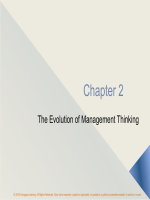Management 12e by w griffin ch02
Bạn đang xem bản rút gọn của tài liệu. Xem và tải ngay bản đầy đủ của tài liệu tại đây (1.27 MB, 32 trang )
TWELFTH EDITION
MANAGEMENT
Ricky W. Griffin
Part One: Introducing Management
Chapter Two: Traditional and Contemporary Management Perspectives
© 2017 Cengage Learning. All rights reserved. May not be copied, scanned, or duplicated, in whole or in part, except for use as permitted in a license distributed with a certain product or service or otherwise on a password-protected
website for classroom use.
2-1
Learning Outcomes
1.
2.
3.
Justify the importance of history and theory to management, and discuss
precursors to modern management theory.
Summarize and evaluate the classical perspective on management, including
scientific and administrative management, and note its relevance to contemporary
managers.
Summarize and evaluate the behavioral perspective on management, including
the Hawthorne studies, the human relations movement, and organizational
behavior, and note its relevance to contemporary managers.
© 2017 Cengage Learning. All rights reserved. May not be copied, scanned, or duplicated, in whole or in part, except for use as permitted in a license distributed with a certain product or service or otherwise on a password-protected
website for classroom use.
2-2
Learning Outcomes
4.
5.
6.
Summarize and evaluate the quantitative perspective on management, including
management science and operations management, and note its relevance to
contemporary managers.
Discuss the systems and contingency approaches to management, and explain
their potential for integrating the other areas of management.
Identify and describe contemporary management issues and challenges.
© 2017 Cengage Learning. All rights reserved. May not be copied, scanned, or duplicated, in whole or in part, except for use as permitted in a license distributed with a certain product or service or otherwise on a password-protected
website for classroom use.
2-3
Importance of Theory and History
Theory
A conceptual framework for organizing knowledge and
providing a blueprint for action.
© 2017 Cengage Learning. All rights reserved. May not be copied, scanned, or duplicated, in whole or in part, except for use as permitted in a license distributed with a certain product or service or otherwise on a password-protected
website for classroom use.
2-4
Importance of Theory and History
Management theories are grounded in reality.
– Theories are used to build organizations and guide them toward their goals.
Understanding the historical context provides a sense of heritage and
helps managers avoid mistakes of others.
© 2017 Cengage Learning. All rights reserved. May not be copied, scanned, or duplicated, in whole or in part, except for use as permitted in a license distributed with a certain product or service or otherwise on a password-protected
website for classroom use.
2-5
Figure 2.1
Management in Antiquity
This simple time line shows a few of the most important management
breakthroughs and practices over the last 4,000 years.
© 2017 Cengage Learning. All rights reserved. May not be copied, scanned, or duplicated, in whole or in part, except for use as permitted in a license distributed with a certain product or service or otherwise on a password-protected
website for classroom use.
2-6
Early Management Pioneers
Robert Owen
– One of the first managers to recognize the importance of human resources.
– He raised working age for children, reduced hours, and supplied meals.
Charles Babbage
– Mathematically focused on efficiency of production.
– Believed in division of labor.
© 2017 Cengage Learning. All rights reserved. May not be copied, scanned, or duplicated, in whole or in part, except for use as permitted in a license distributed with a certain product or service or otherwise on a password-protected
website for classroom use.
2-7
Classical Management Perspective
Consists of two branches – scientific management and
Classical Management
administrative management.
Perspective
Focuses on ways to improve the
production of individual workers.
Scientific Management
Administrative
Management
Focuses on managing the total
organization.
© 2017 Cengage Learning. All rights reserved. May not be copied, scanned, or duplicated, in whole or in part, except for use as permitted in a license distributed with a certain product or service or otherwise on a password-protected
website for classroom use.
2-8
Figure 2.2
Steps in Scientific Management
Frederick Taylor saw workers soldiering, or deliberately working below
their potential. He devised this four step method to overcome the
problem.
© 2017 Cengage Learning. All rights reserved. May not be copied, scanned, or duplicated, in whole or in part, except for use as permitted in a license distributed with a certain product or service or otherwise on a password-protected
website for classroom use.
2-9
Scientific Management
Frank and Lillian Gilbreth
– They developed numerous techniques and strategies for eliminating inefficiency.
Henry Gantt
– Introduced the Gantt chart for scheduling work.
Harrington Emerson
– An advocate for specialized management roles.
© 2017 Cengage Learning. All rights reserved. May not be copied, scanned, or duplicated, in whole or in part, except for use as permitted in a license distributed with a certain product or service or otherwise on a password-protected
website for classroom use.
2 - 10
Administrative Management
Henri Fayol
Lyndall Urwick
Max Weber
Chester Barnard
– First to identify the four management functions.
– Integrated scientific and administrative management.
– Studied efficient organizational structure.
– Wrote about acceptance of authority.
© 2017 Cengage Learning. All rights reserved. May not be copied, scanned, or duplicated, in whole or in part, except for use as permitted in a license distributed with a certain product or service or otherwise on a password-protected
website for classroom use.
2 - 11
Classical Management Today
Contributions
Limitations
– Laid the foundation for management theory.
– Identified key processes, functions, and skills.
– Made management a valid subject of study.
– Best used in simple, stable organizations.
– Universal procedures may not be appropriate in some settings.
– Employees not viewed as resources.
© 2017 Cengage Learning. All rights reserved. May not be copied, scanned, or duplicated, in whole or in part, except for use as permitted in a license distributed with a certain product or service or otherwise on a password-protected
website for classroom use.
2 - 12
Table 2.1
Classical Management Perspective
© 2017 Cengage Learning. All rights reserved. May not be copied, scanned, or duplicated, in whole or in part, except for use as permitted in a license distributed with a certain product or service or otherwise on a password-protected
website for classroom use.
2 - 13
Behavioral Management Perspective
Behavioral
management
Emphasizes
individual
attitudes andperspective
behaviors and group
processes.
Hugo Munsterberg applied psychology to the industrial setting, founding the field of industrial
psychology.
Mary Parker Follett was an early pioneer of this theory.
© 2017 Cengage Learning. All rights reserved. May not be copied, scanned, or duplicated, in whole or in part, except for use as permitted in a license distributed with a certain product or service or otherwise on a password-protected
website for classroom use.
2 - 14
Behavioral Management Perspective
Conducted the Hawthorne Studies
– Found increased productivity in both control and experimental group.
•
Later attributed to heightened employee morale due to extra attention.
Later studies identified:
•
“rate busters” (overproducers) and “chiselers” (underproducers).
Their conclusion:
•
Human behavior was much more important in the workplace than previously believed.
© 2017 Cengage Learning. All rights reserved. May not be copied, scanned, or duplicated, in whole or in part, except for use as permitted in a license distributed with a certain product or service or otherwise on a password-protected
website for classroom use.
2 - 15
Human Relations Movement
Human relations
movement
•
Argued that workers respond primarily to the social context
of the workplace.
Stemmed from the Hawthorne studies.
A basic assumption is that a manager’s concern for workers will lead to
increased satisfaction and improved performance.
© 2017 Cengage Learning. All rights reserved. May not be copied, scanned, or duplicated, in whole or in part, except for use as permitted in a license distributed with a certain product or service or otherwise on a password-protected
website for classroom use.
2 - 16
Human Relations Movement
Theory X
Theory Y
•
A pessimistic and negative view of workers consistent with the views
of scientific management.
•
A positive view of workers; it represents the assumptions that human
relations advocates make.
Includes Maslow’s Hierarchy of Needs and Douglas McGregor’s Theory X and
Theory Y.
© 2017 Cengage Learning. All rights reserved. May not be copied, scanned, or duplicated, in whole or in part, except for use as permitted in a license distributed with a certain product or service or otherwise on a password-protected
website for classroom use.
2 - 17
Theory X and Theory Y
Source: D. McGregor and W. Bennis, The Human Side Enterprise: 25
th
Anniversary Printing, 1985.
© 2017 Cengage Learning. All rights reserved. May not be copied, scanned, or duplicated, in whole or in part, except for use as permitted in a license distributed with a certain product or service or otherwise on a password-protected
website for classroom use.
2 - 18
Emergence of Organizational Behavior
Organizational behavior
•
Contemporary field focusing on behavioral perspectives on management.
Organizational behavior takes a holistic view of behavior and addresses individual,
group, and organization processes.
© 2017 Cengage Learning. All rights reserved. May not be copied, scanned, or duplicated, in whole or in part, except for use as permitted in a license distributed with a certain product or service or otherwise on a password-protected
website for classroom use.
2 - 19
Behavioral Management Today
Contributions
– Gave insights into interpersonal processes.
•
Such as motivation and group dynamics.
– Focused managerial attention on these processes.
– Viewed employees as resources.
Limitations
– Behavior is difficult to predict.
– Managers are reluctant to adopt concepts.
– Research ineffectively communicated to managers.
© 2017 Cengage Learning. All rights reserved. May not be copied, scanned, or duplicated, in whole or in part, except for use as permitted in a license distributed with a certain product or service or otherwise on a password-protected
website for classroom use.
2 - 20
Table 2.3
Behavioral Management Perspective
© 2017 Cengage Learning. All rights reserved. May not be copied, scanned, or duplicated, in whole or in part, except for use as permitted in a license distributed with a certain product or service or otherwise on a password-protected
website for classroom use.
2 - 21
Quantitative Management Perspective
Applies quantitative techniques to management.
Quantitative
Focuses on decision-making, economic effectiveness,
management
mathematical models, and the use of computers.
perspective
Management science
Operations
management
Concerned with helping the organization
more efficiently produce its products or
services.
Focuses specifically on the development of
mathematical models.
© 2017 Cengage Learning. All rights reserved. May not be copied, scanned, or duplicated, in whole or in part, except for use as permitted in a license distributed with a certain product or service or otherwise on a password-protected
website for classroom use.
2 - 22
Quantitative Management Today
Contributions
– Sophisticated techniques assist decision-making.
•
Particularly useful in planning and controlling.
– Increased awareness of complex processes.
Limitations
– Cannot fully explain or predict behavior.
– Mathematical sophistication may come at the expense of other important skills.
– Models may require unrealistic assumptions.
© 2017 Cengage Learning. All rights reserved. May not be copied, scanned, or duplicated, in whole or in part, except for use as permitted in a license distributed with a certain product or service or otherwise on a password-protected
website for classroom use.
2 - 23
Table 2.4
Quantitative Management Perspective
© 2017 Cengage Learning. All rights reserved. May not be copied, scanned, or duplicated, in whole or in part, except for use as permitted in a license distributed with a certain product or service or otherwise on a password-protected
website for classroom use.
2 - 24
Integrating Perspectives for Managers
Systems Perspective
– A system is an interrelated set of elements functioning as a whole.
– An open system is one that interacts with its environment.
– A closed system does not interact with its environment.
– A subsystem is a system within another system.
© 2017 Cengage Learning. All rights reserved. May not be copied, scanned, or duplicated, in whole or in part, except for use as permitted in a license distributed with a certain product or service or otherwise on a password-protected
website for classroom use.
2 - 25









